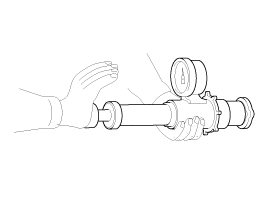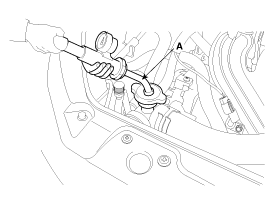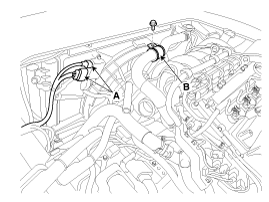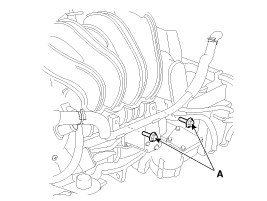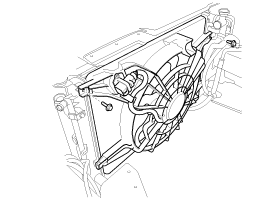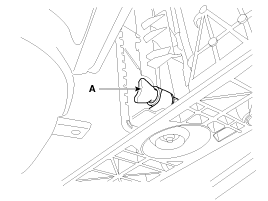Kia Optima Hybrid: Cooling System / Radiator Repair procedures
| Inspection |
| 1. |
Remove the radiator cap, wet its seal with engine coolant, and then install it on a pressure tester.
|
| 2. |
Apply a pressure of 93.16 ~ 122.58kPa (0.95 ~ 1.25kgf/cm?, 13.51 ~ 17.78psi). |
| 3. |
Check for a drop in pressure. |
| 4. |
If the pressure drops, replace the cap. |
| 1. |
Wait until engine is cool, then carefully remove the radiator
cap and fill the radiator with engine coolant, then install it on the
pressure tester (A).
|
| 2. |
Apply a pressure tester to the radiator and apply a pressure of 93.16 ~ 122.58kPa (0.95 ~ 1.25kgf/cm?, 13.51 ~ 17.78psi). |
| 3. |
Inspect for engine coolant leaks and a drop in pressure. |
| 4. |
Remove the tester and reinstall the radiator cap.
|
| Removal and Installation |
| 1. |
Disconnect the battery negative terminals. (Refer to Engine and transaxle assembly in this group) |
| 2. |
Remove the air cleaner assembly. (Refer to Engine and transaxle assembly in this group) |
| 3. |
Disconnect the fan motor connector (A). |
| 4. |
Remove the radiator upper hose clip (B).
|
| 5. |
Remove the EWP(Electric water pump) inlet pipe mounting bolts (A).
|
| 6. |
Remove the cooling fan assembly (A).
|
| 7. |
Remove the under cover. (Refer to Engine and transaxle assembly in this group) |
| 8. |
Loosen the drain plug (A), and drain the engine coolant. Remove the radiator cap to help drain the coolant faster.
|
| 9. |
Disconnect the over flow hose (A) from the radiator.
|
| 10. |
Disconnect the radiator upper hose (A) and lower hose (B).
|
| 11. |
Remove the radiator mounting brackets (A).
|
| 12. |
Drain the inverter coolant and then disconnect the inverter radiator hoses. (Refer to HT group - "Coolant") |
| 13. |
Separate the condenser from the radiator and then remove the radiator assembly (A).
|
| 14. |
Disassemble the inverter radiator (A) from the radiator assembly (B). (Refer to HT group - "Radiator")
|
| 15. |
Installation is the reverse order of removal. |
| 16. |
Fill the radiator with coolant and check for leaks.
|
 Radiator Components and Components Location
Radiator Components and Components Location
Components 1. Cooling fan assembly2. Radiator assembly3. Mounting insulator4. Radiator mounting bracket5. Radiator upper hose6. Radiator lower hose7. Reservoir tank8. Over flow hose ...
 Water pump Components and Components Location
Water pump Components and Components Location
Components 1. Water pump pulley2. Dust cover3. Water pump sub assembly (Water pump housing)4. Water pump housing gasket5. Water pump cover6. Water pump gasket7. Water inlet pipe gasket (O-ring)8. Water ...
Other information:
Kia Optima Hybrid (TF HEV) 2016-2020 Service Manual: Description and Operation
OBD-II review 1. Overview The California Air Resources Board (CARB) began regulation of On Board Diagnostics (OBD) for vehicles sold in California beginning with the 1988 model year. The first phase, OBD-I, required monitoring of the fuel metering system, Exhaust Gas Recirculation (EGR) system and additional ...
Kia Optima Hybrid (TF HEV) 2016-2020 Service Manual: TPMS Receiver Description and Operation
Description It automatically searches the sensor location and learns new sensors. It uses the sensor information, distance travelled, indistinct noise, automatic learning status, vehicle battery condition and inner receiver condition to determine whether there is defect in system or vehicle. Mode 1. ...

